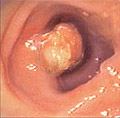Colonic polyp: Difference between revisions
imported>Robert Badgett No edit summary |
imported>Meg Taylor No edit summary |
||
| Line 62: | Line 62: | ||
==References== | ==References== | ||
{{reflist}} | |||
Revision as of 04:44, 3 October 2013
| Colonic polyp | |
|---|---|
| Colonic polyp | |
| ICD-9 | V12.72 |
| OMIM | 175100 |
| MeSH | D003111 |
In medicine, colonic polyps are "discrete tissue masses that protrude into the lumen of the colon. These polyps are connected to the wall of the colon either by a stalk, pedunculus, or by a broad base."[1] Colonic polyps may become colorectal cancer.
Classification
In a study of 2531 volunteers 50 years of age or older:[2]
- 1629 (64%) had no polyps
- 902 (36%) had polyps
- 512 (57% of the 902) had polyps with the largest being less than 5 mm in size
- 258 (29% of the 902) had 392 polyps with the largest being 5 mm - 9 mm in size
- 246 (63% of the 392 polyps) were adenomatous
- 146 (27% of the 392 polyps) were non-adenomatous such as hyperplastic polyps and lipomas
- 132 (15% of the 902) had 155 polyps with the largest being 10 mm or larger in size
- 121 (78% of the 155 polyps) were adenomatous
- 7 (5% of the 155 polyps) were carcinomas
- 27 (17% of the 155 polyps) were non-adenomatous
Hyperplastic polpys
Adenomatous polyps
Adenomatous colonic polyps are common and are present in 25% of men and 15% of women undergoing screening colonoscopy.[3]
- Tubular adenomas
- Tubulovillous adenomas
- Villous adenomas
Diagnosis
CT scan may be used.[4][2][5][6]
Prognosis
| Polyp size | Cancer % (confidence interval) |
Villous histology or high-grade dysplasia % (confidence interval) |
Total % (confidence interval) |
|---|---|---|---|
| < 4 mm | 0 (0–.36) | 1.68 (.87–2.49) | 1.68 (.87–2.49) |
| 5–9 mm | 0.87% (.26–1.48) | 9.23 (7.32–11.14) | 10.10 (8.11–12.08) |
| > 10 mm | 5% |
Adenomatous colonic polyps may progress to colorectal cancer; however, less than 10% do so.[3] The rate of progression to invasive cancer among polyps of at least 10 mm size is about 1% per year.[8]
High risk colonic polyps are defined as either:[9]
- 3 or more synchronous adenomas
- Adenomas ≥1 cm in diameter
- Villous histology or high-grade dysplasia
The risk of current dysplasia depends on the size of the polyp (see table).[7] Similar numbers have been reported by other studies.[10] The risk of recurrence of future high risk histology is also correlated with size.[11]
References
- ↑ Anonymous (2024), Colonic polyp (English). Medical Subject Headings. U.S. National Library of Medicine.
- ↑ 2.0 2.1 2.2 Johnson CD, Chen MH, Toledano AY, et al (September 2008). "Accuracy of CT colonography for detection of large adenomas and cancers". The New England journal of medicine 359 (12): 1207–17. DOI:10.1056/NEJMoa0800996. PMID 18799557. Research Blogging.
Cite error: Invalid
<ref>tag; name "pmid18799557" defined multiple times with different content Cite error: Invalid<ref>tag; name "pmid18799557" defined multiple times with different content - ↑ 3.0 3.1 Levine JS, Ahnen DJ (December 2006). "Clinical practice. Adenomatous polyps of the colon". The New England journal of medicine 355 (24): 2551–7. DOI:10.1056/NEJMcp063038. PMID 17167138. Research Blogging.
- ↑ Regge D, Laudi C, Galatola G, Della Monica P, Bonelli L, Angelelli G et al. (2009). "Diagnostic accuracy of computed tomographic colonography for the detection of advanced neoplasia in individuals at increased risk of colorectal cancer.". JAMA 301 (23): 2453-61. DOI:10.1001/jama.2009.832. PMID 19531785. Research Blogging.
- ↑ Kim DH, Pickhardt PJ, Taylor AJ, Leung WK, Winter TC, Hinshaw JL et al. (2007). "CT colonography versus colonoscopy for the detection of advanced neoplasia.". N Engl J Med 357 (14): 1403-12. DOI:10.1056/NEJMoa070543. PMID 17914041. Research Blogging.
- ↑ Rockey DC, Paulson E, Niedzwiecki D, Davis W, Bosworth HB, Sanders L et al. (2005 Jan 22-28). "Analysis of air contrast barium enema, computed tomographic colonography, and colonoscopy: prospective comparison.". Lancet 365 (9456): 305-11. DOI:10.1016/S0140-6736(05)17784-8. PMID 15664225. Research Blogging. Review in: ACP J Club. 2005 Jul-Aug;143(1):22
- ↑ 7.0 7.1 Butterly LF, Chase MP, Pohl H, Fiarman GS (March 2006). "Prevalence of clinically important histology in small adenomas". Clinical gastroenterology and hepatology : the official clinical practice journal of the American Gastroenterological Association 4 (3): 343–8. DOI:10.1016/j.cgh.2005.12.021. PMID 16527698. Research Blogging.
- ↑ Stryker SJ, Wolff BG, Culp CE, Libbe SD, Ilstrup DM, MacCarty RL (November 1987). "Natural history of untreated colonic polyps". Gastroenterology 93 (5): 1009–13. PMID 3653628. [e]
- ↑ Winawer SJ, Zauber AG, Fletcher RH, et al (May 2006). "Guidelines for colonoscopy surveillance after polypectomy: a consensus update by the US Multi-Society Task Force on Colorectal Cancer and the American Cancer Society". Gastroenterology 130 (6): 1872–85. DOI:10.1053/j.gastro.2006.03.012. PMID 16697750. Research Blogging.
- ↑ Pickhardt PJ, Hassan C, Laghi A, et al (November 2008). "Clinical management of small (6- to 9-mm) polyps detected at screening CT colonography: a cost-effectiveness analysis". AJR Am J Roentgenol 191 (5): 1509–16. DOI:10.2214/AJR.08.1010. PMID 18941093. Research Blogging.
- ↑ Laiyemo AO, Murphy G, Albert PS, et al (March 2008). "Postpolypectomy colonoscopy surveillance guidelines: predictive accuracy for advanced adenoma at 4 years". Ann. Intern. Med. 148 (6): 419–26. PMID 18347350. [e]
